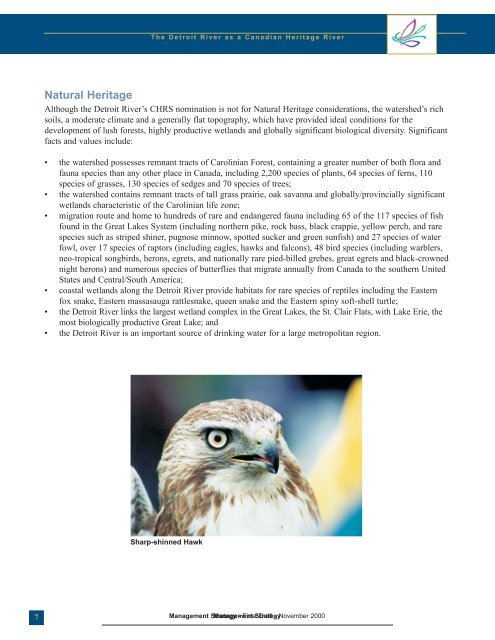Detroit River Management Strategy - Essex Region Conservation ...
Detroit River Management Strategy - Essex Region Conservation ...
Detroit River Management Strategy - Essex Region Conservation ...
You also want an ePaper? Increase the reach of your titles
YUMPU automatically turns print PDFs into web optimized ePapers that Google loves.
##7<br />
Natural Heritage<br />
The <strong>Detroit</strong> <strong>River</strong> as a Canadian Heritage <strong>River</strong><br />
Although the <strong>Detroit</strong> <strong>River</strong>’s CHRS nomination is not for Natural Heritage considerations, the watershed’s rich<br />
soils, a moderate climate and a generally flat topography, which have provided ideal conditions for the<br />
development of lush forests, highly productive wetlands and globally significant biological diversity. Significant<br />
facts and values include:<br />
• the watershed possesses remnant tracts of Carolinian Forest, containing a greater number of both flora and<br />
fauna species than any other place in Canada, including 2,200 species of plants, 64 species of ferns, 110<br />
species of grasses, 130 species of sedges and 70 species of trees;<br />
• the watershed contains remnant tracts of tall grass prairie, oak savanna and globally/provincially significant<br />
wetlands characteristic of the Carolinian life zone;<br />
• migration route and home to hundreds of rare and endangered fauna including 65 of the 117 species of fish<br />
found in the Great Lakes System (including northern pike, rock bass, black crappie, yellow perch, and rare<br />
species such as striped shiner, pugnose minnow, spotted sucker and green sunfish) and 27 species of water<br />
fowl, over 17 species of raptors (including eagles, hawks and falcons), 48 bird species (including warblers,<br />
neo-tropical songbirds, herons, egrets, and nationally rare pied-billed grebes, great egrets and black-crowned<br />
night herons) and numerous species of butterflies that migrate annually from Canada to the southern United<br />
States and Central/South America;<br />
• coastal wetlands along the <strong>Detroit</strong> <strong>River</strong> provide habitats for rare species of reptiles including the Eastern<br />
fox snake, Eastern massasauga rattlesnake, queen snake and the Eastern spiny soft-shell turtle;<br />
• the <strong>Detroit</strong> <strong>River</strong> links the largest wetland complex in the Great Lakes, the St. Clair Flats, with Lake Erie, the<br />
most biologically productive Great Lake; and<br />
• the <strong>Detroit</strong> <strong>River</strong> is an important source of drinking water for a large metropolitan region.<br />
Sharp-shinned Hawk<br />
<strong>Management</strong> <strong>Strategy</strong> <strong>Management</strong> - Final <strong>Strategy</strong> Draft - November 2000


